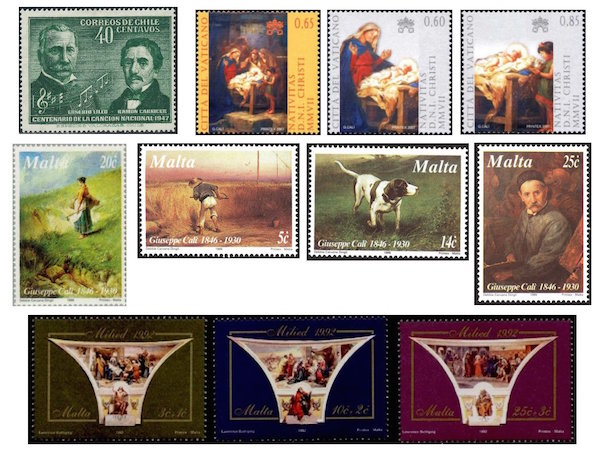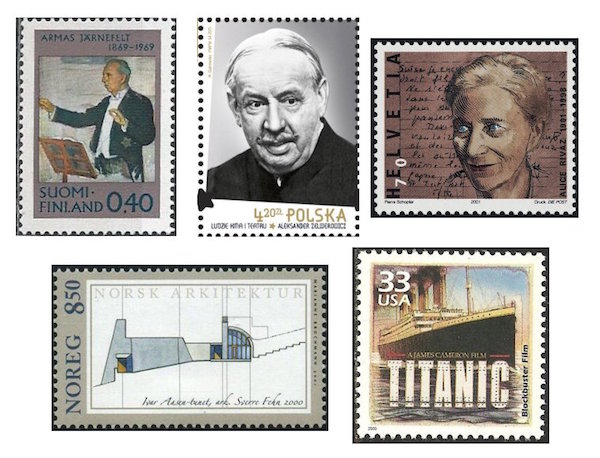The Arts on Stamps of the World — August 14
An Arts Fuse regular feature: the arts on stamps of the world.

By Doug Briscoe
The author of The Forsyte Saga and 1932 Nobel Prize winner John Galsworthy (14 August 1867 – 31 January 1933) tops our program today. While traveling by sea he met and became friends with Joseph Conrad. Galsworthy’s first works were published under the pen name John Sinjohn, and it was only after the death of his father that he used his own. The first of his many plays, The Silver Box (1906), dates from the same year as the first volume of The Forsyte Saga. Galsworthy was an advocate of prison reform, women’s rights, and animal welfare and an opponent of censorship. He was unable to attend the ceremony for his Nobel Prize and died six weeks later.
German filmmaker Wim Wenders (born 14 August 1945) turns 72 today. Although his masterpieces Paris, Texas (1984) and Wings of Desire (1987) have earned the spotlight, it is perhaps Wenders’s documentaries that will prove to be his most consistent triumphs. Among other awards, Paris, Texas won the Palme d’Or at Cannes, and Wenders earned best director honors there for Wings of Desire, which is commemorated on the German stamp of 1995. Meanwhile, it has been the documentaries Buena Vista Social Club (1999), Pina (2011), and The Salt of the Earth (2014) that have been nominated for Oscars.
It so happens that French painter Claude-Joseph Vernet (14 August 1714 – 3 December 1789) and his artist son Carle were both born on 14 August, but I could find stamps only for Vernet père. (His grandson Horace has a stamp or two, but that birthday was in June. Since I missed it then, I may as well include him today.) Claude-Joseph was born in Avignon and assisted his father Antoine decorating sedan chairs and the like. Claude-Joseph determined on a more elevated artistic career and boarded a ship for Italy. On seeing whales for the first time he was so moved that he began his studies with a Civitavecchian artist who specialized in painting the great cetaceans. Seascapes would always be central to Vernet’s output. He lived in Rome for twenty years, then was commissioned to do a series of paintings of French ports. One of the most admired of these is The Port of Rochefort (1763). Both of the Cuban stamps, one from 1983, the other from 1989, show the same painting, Fishermen in Port. As I mentioned, the work of Claude-Joseph’s son Carle (in full Antoine Charles Horace Vernet, 14 August 1758 – 17 November 1836) is not represented on any stamps I could find, but I thought I’d include links to a couple of his pieces: Turkish Groom Holding An Arab Stallion and an equestrian portrait of Napoleon. As for the grandson, Émile Jean-Horace Vernet (30 June 1789 – 17 January 1863), he concentrated on battle scenes, portraits, and Orientalist pieces. Another Cuban stamp, however, shows a still life of flowers, and a minisheet from Chad offers La calèche.

The Chilean poet and journalist Eusebio Lillo Robles (August 14, 1826 – July 8, 1910) was the author of new lyrics for the Chilean National Anthem in 1847. There had been an earlier anthem in use before 1828, and Ramón Carnicer wrote the music for a new one around 1827, but the original lyrics exhibited strongly anti-Spanish sentiments, and by 1847, when Chile had been independent for nearly thirty years, it was felt that a new text was called for. Though independent, Chile was still entrenched in conservatism, and the liberally inclined Lillo supported the revolution of 1851. For this he was exiled (originally condemned to death) but was back the next year, remaining until 1857, when he moved to Bolivia until 1878. He returned to serve in the liberal governments of President Aníbal Pinto and his successors, acting as mayor of Santiago, senator of Talca, and a diplomat.
Although his name is not well known in this country, Maltese painter Giuseppe Calì (August 14, 1846 – March 1, 1930) is represented on more stamps than any of our other subjects today. He was born in Valletta to Neapolitan parents (his mother was a mezzo-soprano) and educated in Naples. His best known work is The Death of Dragut (1867). Other biographical information is scanty, but he was quite prolific, producing mostly religious paintings, and his work can be found in almost every important church on the island. The Nativity, seen on three Maltese stamps of 2007, is situated in the Parish Church of St. Andrew in Luqa. The set of four stamps from 1996 includes Countrywoman in a Field (at the beginning of the second row), but I wasn’t able to learn the titles of the next two pictures. The portrait of Calò is by Edward Caruana Dingli (1876-1950). The bottom set of stamps shows three works from the Rotunda of Mosta. If you follow the supplied link, you can click on thumbnails for all three: Nativity scene (thumbnail at upper right on the Rotunda website), Adoration of the Magi (third row center), and Christ among the Elders in the Temple (third row left).
August 14 is also the birthday of Armas Järnefelt (1869 – 23 June 1958), a Finnish composer and conductor who was related by marriage to Sibelius: Järnefelt’s sister Aino was Sibelius’s wife. He was born in what was then the Grand Duchy of Finland and studied under Busoni in Helsinki and Massenet in Paris. He was the first conductor to lead performances of Wagner’s operas in Finland, but became a Swedish citizen in 1909 and died in Stockholm a half-century later. His rather small output of orchestral works includes a Symphonic Fantasy, a Serenade, and a Suite, besides his most popular score, a Berceuse for small orchestra. All of these pieces are gathered together on a Bis CD. He also wrote choruses, songs, piano pieces, incidental music, and film scores.

Polish actor, singer, and stage director Aleksander Zelwerowicz (zel-veh-RO-vitch, 14 August 1877 – 18 June 1955) had a repertoire that encompassed some 900 roles. He appeared in about two dozen films between 1912 and 1941. Zelwerowicz was director of the Warsaw National Theater, which was renamed for him in 1955, and with Leon Schiller was co-founder in 1932 of the National Institute of Dramatic Arts. He was a member of the Polish Resistance during World War II and is one of the many Poles distinguished as Righteous Among the Nations.
The Swiss author Alice Rivaz (August 14, 1901 – February 27, 1998) studied music in hopes of becoming a concert pianist, then worked for some years with the UN’s International Labor Organization. She turned to writing only later, publishing her first novel, Clouds in Your Hands (Nuages dans la main), when she was nearly forty years of age. During the war years she was rather at loose ends, resuming her writing with her second and third novels in 1946-47. Thereafter came an even longer hiatus before the appearance of her short story collection Without Alcohol (Sans Alcool) in 1961. There followed a string of volumes of fiction, essays, and diaries, often dealing with matters of feminism. Born in a small community, she lived most of her long life in Geneva, and died there at the age of 96. She is buried close to Ernest Ansermet und Alberto Ginastera.
Sverre Fehn (14 August 1924 – 23 February 2009) is held to have been the preeminent Norwegian architect of his generation. Winner of the Pritzker Prize in 1997, he first came to international notice with his design for the Norwegian Pavilion at the 1958 Brussels World Exhibition. Later works of distinction include the Hedmark Museum in the town of Hamar, a transparent structure which houses the ruins of a medieval cathedral, and the Ivar Aasen Center of 2000, limned on a Norwegian stamp from the following year.

One of the top names among recent film music composers was that of James Horner (August 14, 1953 – June 22, 2015), who was killed just two years ago while piloting his own airplane. Among his very many film scores are those for Ron Howard’s Cocoon and James Cameron’s Aliens and Titanic, which last was such a hit that it got its own stamp as part of the postal service’s retrospective of the 1990s.
Honorable mention—but no stamp—goes to the brilliant Steve Martin (born August 14, 1945) and to Far Side creator Gary Larson (born August 14, 1950).
A graduate of the University of Massachusetts with a B.A. in English, Doug Briscoe worked in Boston classical music radio, at WCRB, WGBH, and WBUR, for about 25 years, beginning in 1977. He has the curious distinction of having succeeded Robert J. Lurtsema twice, first as host of WGBH’s weekday morning classical music program in 1993, then as host of the weekend program when Robert J.’s health failed in 2000. Doug also wrote liner notes for several of the late Gunther Schuller’s GM Recordings releases as well as program notes for the Boston Classical Orchestra. For the past few years he’s been posting a Facebook “blog” of classical music on stamps of the world, which has now been expanded to encompass all the arts for The Arts Fuse.
